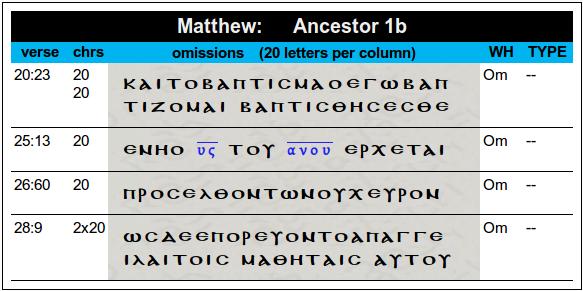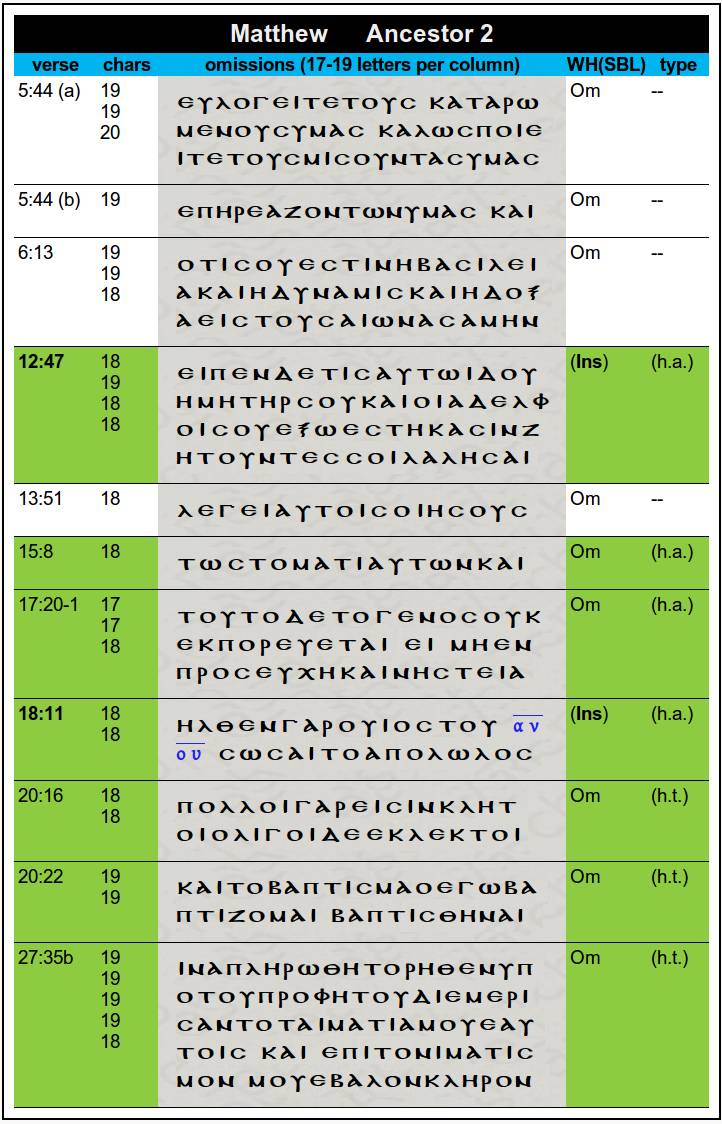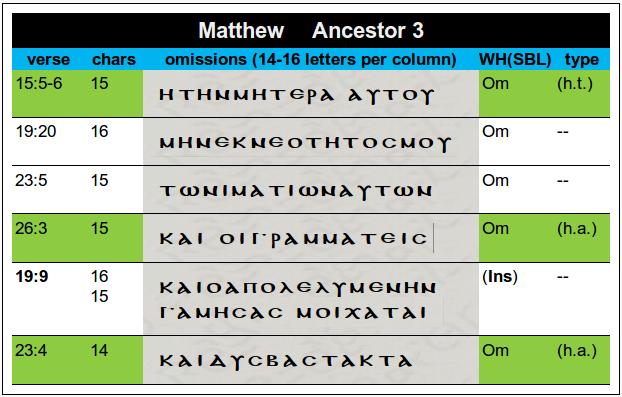 Last Updated: Dec 18, 2010 |
The Ancestors of א/B: |
 Last Updated: Dec 18, 2010 |
The Ancestors of א/B: |
|
Ancestor MSS: - א/B |
Originally the NT books were written separately, and circulated separately, and only later gathered into collections such as the Four Gospels, or the Letters of Paul, into one manuscript copy.
Rightly then has James Snapp Jr. insisted that the early textual history be analyzed separately, book by book:
"2. The text of the New Testament should be reconstructed in its component-parts: Gospels and Acts and Pauline Epistles and General Epistles and Revelation. Relationships shown by patterns of readings in one part should not be assumed to exist in the others."
Grouping and Organizing the Omissions of Aleph/B
If we take then the Gospel of Matthew in hand, and list all the significant omissions by Aleph/B followed by the modern critical GNTs, we make some amazing and enlightening discoveries.
The omissions fall easily into three basic groups, with the missing letter counts being multiples of typical column widths for manuscripts from the late 2nd and early 3rd centuries. In other words, we can reconstruct what some of the ancestors of the common ancestor of Aleph/B looked like, to account for these strong correlations in line-length and column-width.
Since earlier ancestors (late 2nd century) had wider columns, the groups of omissions can be ordered chronologically and traced to the copyist who used such a manuscript as a master-copy.
We expect to find similar results when turning to the other gospels, especially the larger ones, such as Luke. However we cannot extend our findings here until each gospel is checked separately, as many of these errors probably accumulated when the Gospels were circulating either separately or in copies of the Four Gospels, as opposed to whole New Testaments.
This first master-copy had all this text in place, but unfortunately, these half-verses were omitted by the copyist of this manuscript, and transmitted to subsequent copies, later to become incorporated in the ancestor of Aleph/B.
The letters per column of this master-copy varied from 20-22. Longer lines allowed more variation in the count, with lines containing many iotas and upsilons holding a letter or two more than average.


Two of these seven omissions have already been identified as homoeoteleuton from their features. The others haven't the prominent indicators, and were probably just random line-skips. Such occurances were more common in the earlier copies, when quality of copying and proof-reading were less consistent, and where wilder texts seem to have abounded. But the strong coincidence of exactly 20 characters in six of the lines, coupled with the non-significance of the text itself, indicates an accidental error based on column-width.
All of these omissions occur after Chapter 19 of Matthew, and suggest that the copy of this manuscript (which had the text included) was only proof-read and corrected up to chapter 19, again corroborating the likelihood of omission rather than interpolations.
We have taken into account the likely presence of Nomina Sacra, for Matt. 25:13 above, which were in use from earliest times.
Matt. 20:23 may be explained alternately as a deliberate edit (see below, Ancestor 2), in which case its line-length may not be relevant, although it would still be an omission, rather than an insertion.
The next group of readings displays a line-length and likely column-width of about 17-19 characters per line. This is by far the largest group of such eye-skip type errors, with at least six being identified as homoioteleuton/arcton with high probability, from the features. To their individual merit we can now add the fact that they all appear to based on the same column-width, about 18-19 characters per line.
Worth special mention is Matt. 20:22, which is a variation unit that is connected to the almost identical omission at 20:23 from the previous chart above. From the different line lengths, we believe that one or the other of the lines was dropped first, namely this one at verse 22, which presents homoeoteleuton features.
When a subsequent scribe found only the one line at verse 23, it was deleted as an apparent insertion. The original pairing of the sayings was not present to explain the line. If these lines were insertions, they would both have to have been inserted together, and if that were the case, neither the homoeoteleuton features would be explained, nor would the deletion be as attractive to a scribe.
In any case, the majority of the homoeoteleuton examples here are independently quite convincing, and this lends weight to the likelihood that 5:44a, 5:44b and 6:13 were all simple eye-skips by the same scribe who omitted so many other lines of the same length throughout this gospel manuscript. ( 5:44a and 5:44b should be taken together as one Variation Unit because of their close proximity and identical line-length.)

Please note that the above approximate layout does not do justice to the standard practice of evenly spacing the letters in a column, even when the letters themselves are physically different widths. This standardization of spacing seems to be very early, and can be seen on such early papyri fragments as
P. Oxy. 1780 < - - Click here to view.
Finally, we have Ancestor 3, which seems to have been a manuscript very similar to both Vaticanus and Sinaiticus, presenting much narrower columns, of about 15-16 letters per line. The even shorter omissions (especially the homoeoteleuton at 23:4) could have happened by the scribe losing his place on the very same line, due to similar phrases on the same line.
Because of this, it is hard to say just where the last few omissions belong (i.e., 23:4, 5:27, 18:2), since they could have happened anywhere at any time.
Nonetheless, it appears at least one ancestor of the master-copy of Aleph/B was a recent narrow-column copy.


We are now in a position to posit a plausible copy-generation scenario:
Ancestor 1 would decend ultimately from the original, but the number of generations between it and the original Matthew is indeterminable at this time.
This manuscript would have contained a nearly complete and full version of Matthew and was 20-22 characters wide per column. It was copied by Ancestor 2, who unfortunately dropped the lines listed in chart One above.
Ancestor 2 (or a copy of it) was used by the scribe of Ancestor 3. Ancestor 2 (or a copy of it) had columns about 17-19 characters wide, which led to Ancestor 3 dropping another eleven segments of text. Most of these were actual homoeoteleuton errors (6/11), but some were just random slips.
Aleph/B Now the actual ancestor of Aleph/B took a turn, copying Ancestor 3. Unfortunately, due to Ancestor 3 (or a copy of it) being about 15-16 characters wide, the ancestor of Aleph/B lost another half-dozen short lines by a combination of homoeoteleuton and simple eye-skip from fatigue.
This ancestor, perhaps one or two generations away from Aleph and B, had accumulated all the errors of the previous scribes (the ones not caught and corrected, which amounts to our list).
|
Ancestor 1: |
This copy is about 20-22 chars per line, and was probably a very good copy of Matthew, containing most lines omitted by Aleph/B. |
|
| Somewhere along the line, a copyist used Ancestor 1 as a master-copy, but dropped Matt. 20:7, 20:23, 22:13, 23:11b-14, 25:13, 26:60, 28:9. Some copy of this became... |
|
Ancestor 2: |
This copy is about 17-19 chars per line, and is probably a copy of the 4 gospels. Unfortunately, it was uncorrected post-chapter 19. |
|
|
At some point, Ancestor 2 was used as a master, but the copyist was prone to homoeoteleuton, and lost text again in about 11 instances: Matt. 5:44, 6:13, 12:47, 13:51, 15:8, 17:20, 18;11, 20:16, 20:22, 27:35. It was not proof-read ... |
|
Ancestor 3: |
The errors of two or more scribes have gathered in a line isolated from other copying centers. Soon a 15-16 char per line copy is made. |
|
|
The new format introduces another cluster of undetected errors: Matt. 15:5, 19:20, 23:5, 26:3, 19:9. The copyist introducing this last group has created the final common ancestor of Aleph/B for Matthew. |
|
Proto-Aleph/B: |
This master-copy used by the copyists of Aleph and B probably resided in the scriptorium at Caesarea where Aleph and B were made. |
|
|
A few more slips have accumulated along the way in the wild and shakey Alexandrian stream. One or two shared readings might be coincidences, but most will stem from this immediate ancestor of Aleph/B. |
|
א B |
The dying and deficient Alexandrian line of transmission. Erroneously approved of by ecclesiastics, used briefly for preparing other early versions made for public reading, but shortly abandoned for better copies. |

This page powered by:
RefTagger